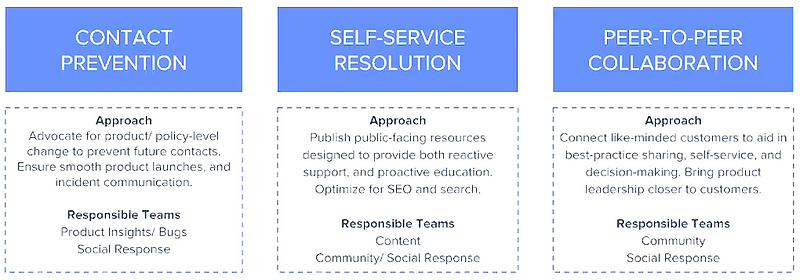How To Build A Scalable Customer Success Strategy
Jack Cohen / 02.05.19
Jack Cohen / 02.05.19

Caty Kobe is the Head of Scalable Customer Success at Square. She oversees a growing team of 25+ employees dedicated to blending insights, content, and technology to deliver proactive and reactive educational resources to customers at scale.
Customer satisfaction is the ultimate validator for product success. And when one of your customers has a question or complaint, the manner and speed in which you respond matter immensely. In the early days, keeping a relatively small customer base happy is achievable with a small team.
But maintaining that level of customer satisfaction as your base grows quickly becomes a daunting task for any startup that doesn’t have a scalable customer success strategy in place. When implemented properly, a strategy like this can proactively prevent tickets, triage inquiries into self-supporting channels, and most importantly, allow your team to focus on the bigger ticket items like serving your top accounts.
We recently welcomed Caty Kobe, Head of Scalable Customer Success at Square, to speak to CS leaders from across the FirstMark family. Square (NYSE: SQ), a leader in financial services technology with a market cap of over $29B, is a mission-critical tool for hundreds of thousands of businesses daily and, as a result, must also service questions from those customers as quickly as possible. Kobe’s team, across five unique disciplines, has enabled Square to self-serve 10-12X the support volume that they handle in their 1:1 channels.
To ensure success at every level, Kobe organizes her team around three main pillars: (1) Contact Prevention, (2) Self-Service Resolution, (3) Peer-To-Peer Collaboration.
Focus On Prevention, Resolution, and Collaboration

Contact Prevention
The first pillar is focused on proactively preventing tickets from ever being created. To do so, Kobe recommends having two micro-teams within the larger Scalable team: one for product insights and one for bugs.
“If you stop the problem before people even have it, that’s going to allow you to scale almost infinitely.”
The product insights team is a small group of analysts responsible for reviewing all of the customer inquiry data that comes in across your frontline teams—whether it’s from a transactional one-to-one channel (phone or email), or from a more public one-to-many channel (social + community platforms). Their main objective is to holistically understand what’s going on behind the data and, most importantly, what issues are driving the most volume.
The bugs team has an equally important role in preventative proactivity. They review every bug that the frontline teams are filing—essentially triaging and reproducing bugs to ensure that only actual problems are sent to the engineering teams to fix. This filtering layer saves countless engineering hours.
Key Takeaway: By focusing on contact prevention, you not only address the issues that are likely costing you the most to solve, but you also prevent broader issues of lost brand trust and reputation, which are much harder to clean up at scale.
Self-Service Resolution
The second pillar that Kobe organizes her team around is self-service resolution. If customers can find relevant content on your site or in-app and answer their own questions without contacting an agent, not only have you avoided a costly ticket, but you’ve also reinforced positive habits in that customer.
Kobe’s Scalable team has a content arm that writes all public-facing support resources customers may interact with. “They write the email templates our agents use, all of the articles that live in our support center, our instant answers that surface throughout our contact flow, even our chatbot content and also manage all of the libraries.” Quick tip: Kobe suggests “thinking like a marketer” when writing this content. Content marketers are best at knowing how to get certain content in front of the right people at the right time, which aligns perfectly with support content.
In addition to the content team, Kobe has a community team that monitors all of the conversations between customers and Square on the community platforms and provides a great two-way communication channel.
Kobe says “the beautiful part about having all of these conversations is not only that [customers] are talking with each other, but also they’re sharing best practices, tips, and other information. Then, my community team reviews all of it to make sure, especially on the product side, that the comments are accurate. And, when they are, we give certain answers our official stamp of approval by tagging them with ‘the best answer.’”
Key Takeaway: By integrating these two systems (community discussions+ in-house support content) and making all of the content easily searched and priority ranked, Kobe triples the volume of Square’s knowledge base content overnight.
Peer-To-Peer Collaboration
The final organizing pillar revolves around peer-to-peer collaboration. Kobe stresses that especially in the SMB world, “there’s no one better to learn about running a business from than another small business, so we really care a lot about connecting those people.”
This is another aspect of Kobe’s strategy where leaning on the community can be a win-win for Square and the businesses it supports.
Kobe shared an example of a customer who surfaced a unique approach to gift cards that her team now shares with the broader customer base: “We have a customer who’s an ice cream shop and his customers leverage our gift cards that he buys through us as almost like a pre-load debit card for their kids. So every summer the kids, the parents come in and they buy the gift card for the kids and then they just reload it on a weekly or a monthly basis. And so that’s a really interesting way of leveraging gift cards that isn’t used by a lot of our other customers and we wouldn’t have found out about that if it weren’t for him sharing his best practices for using gift cards and how he uses them in the community.”
Next